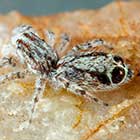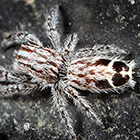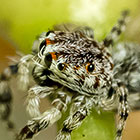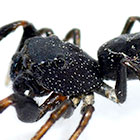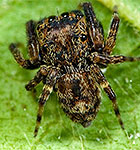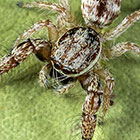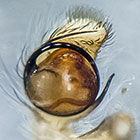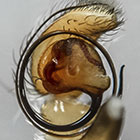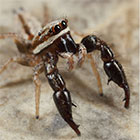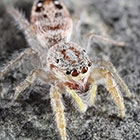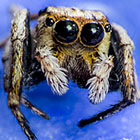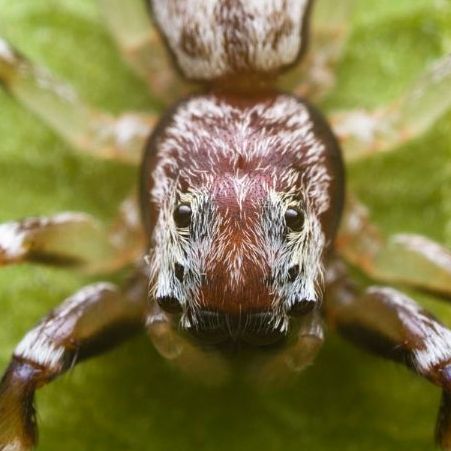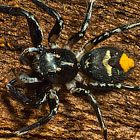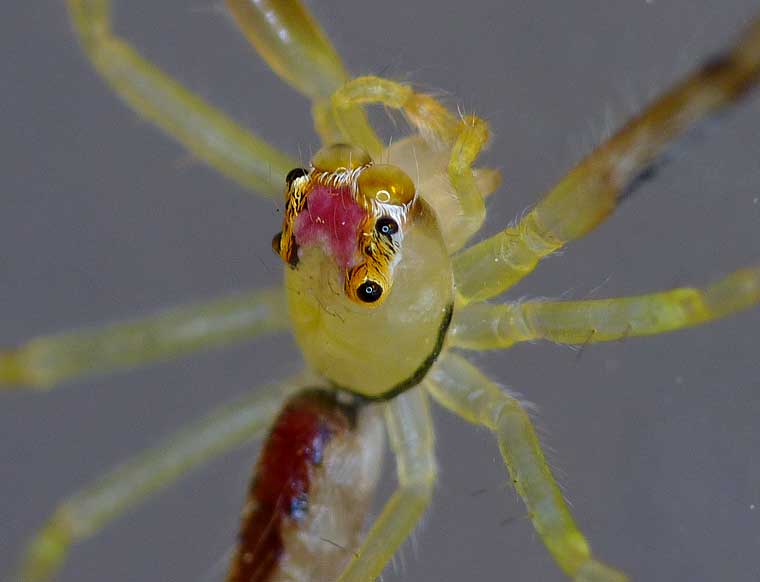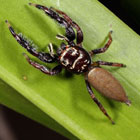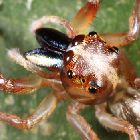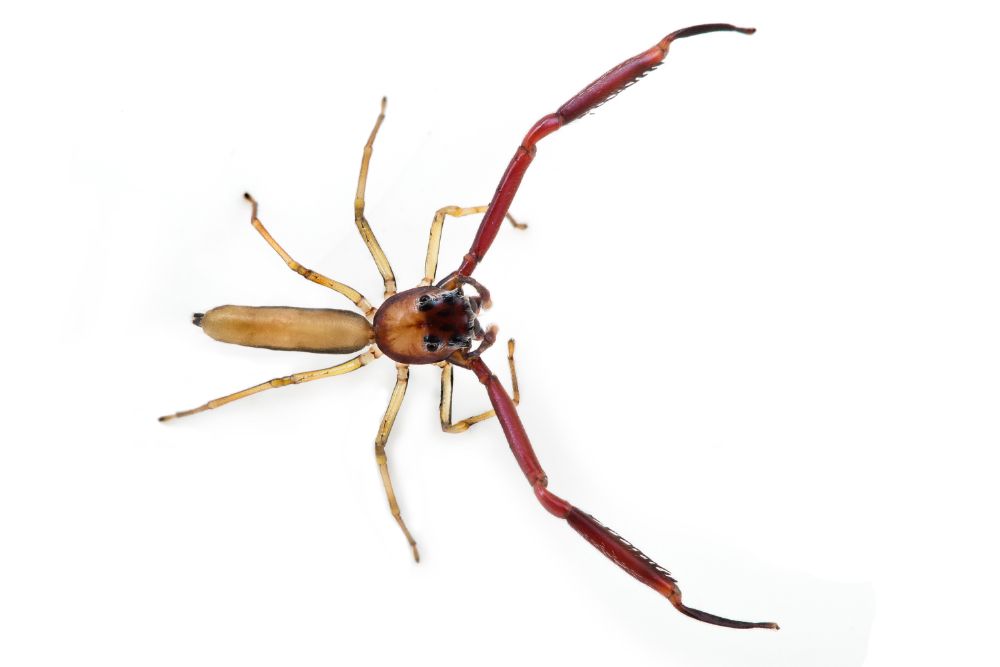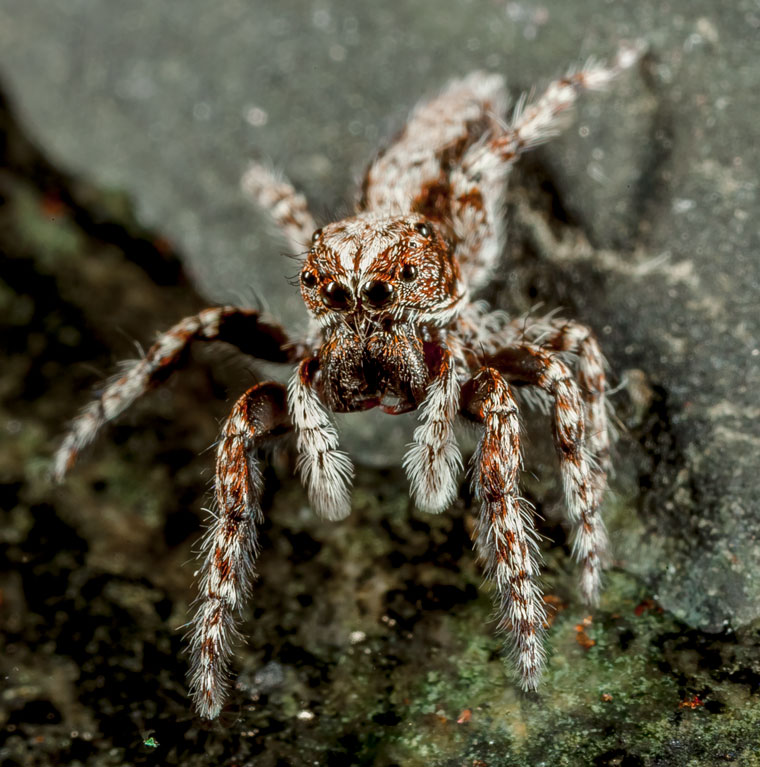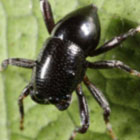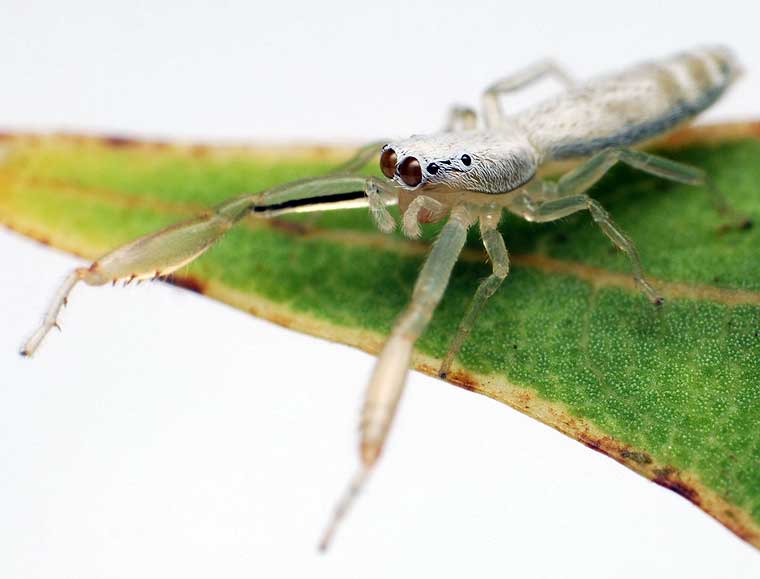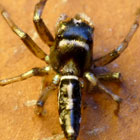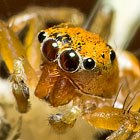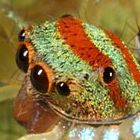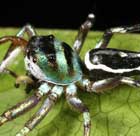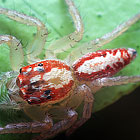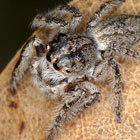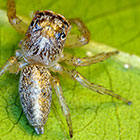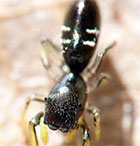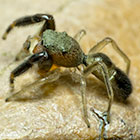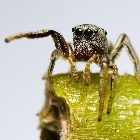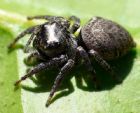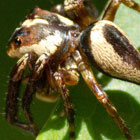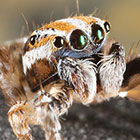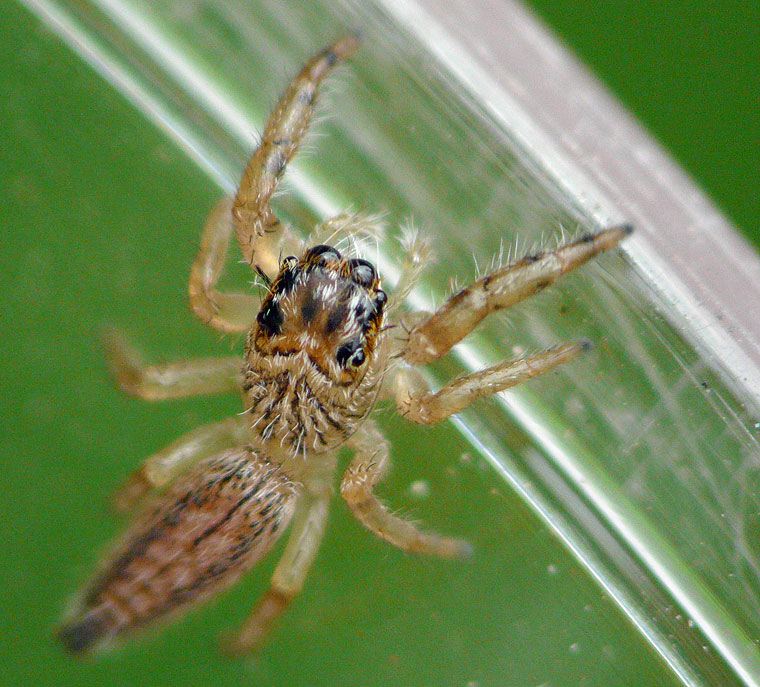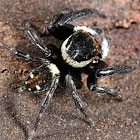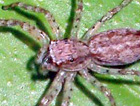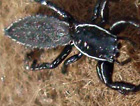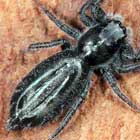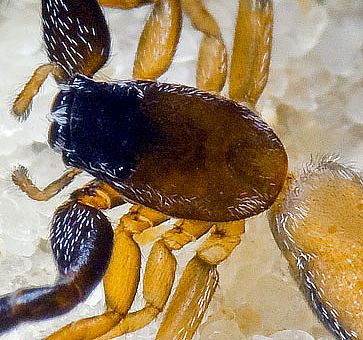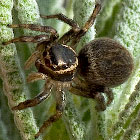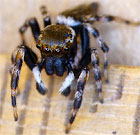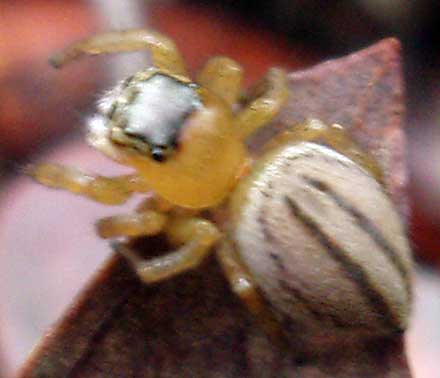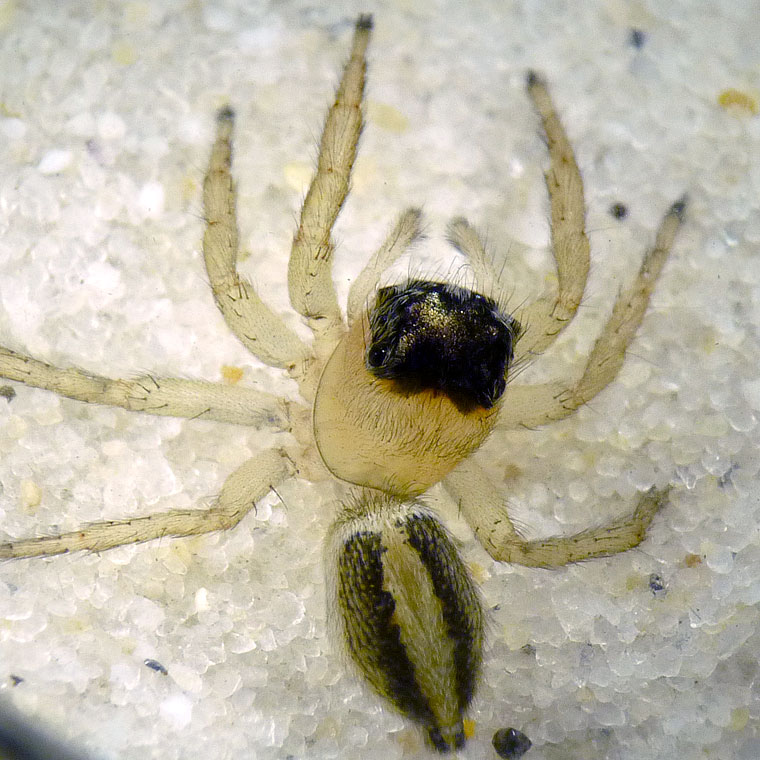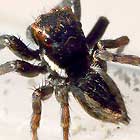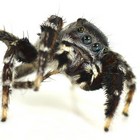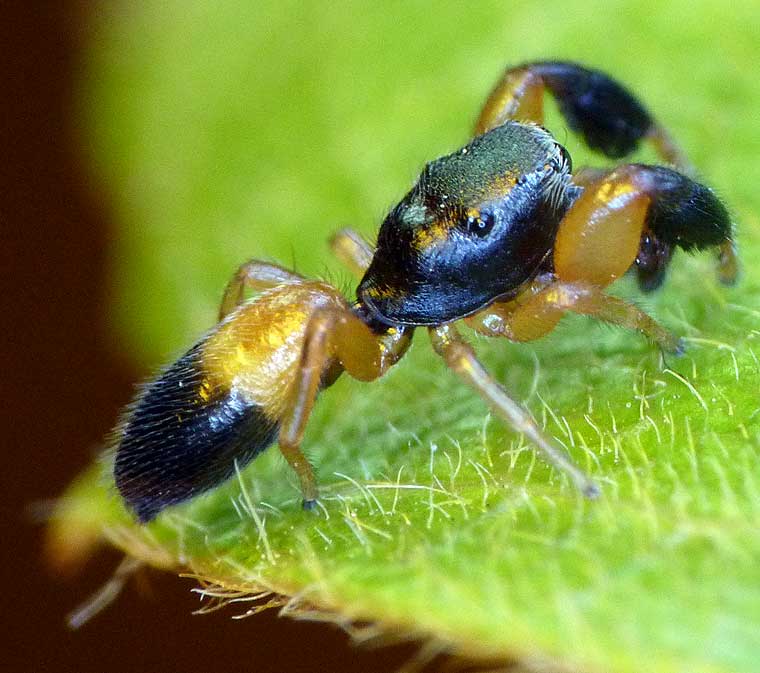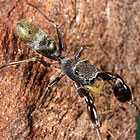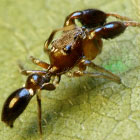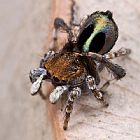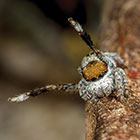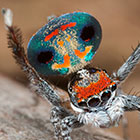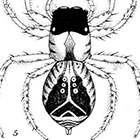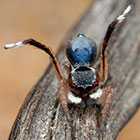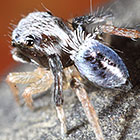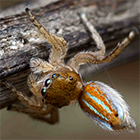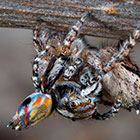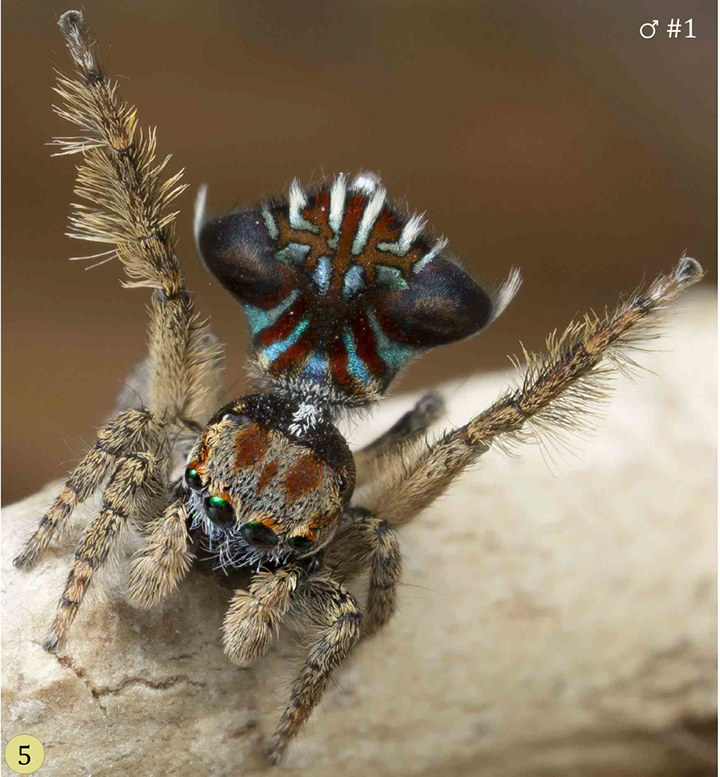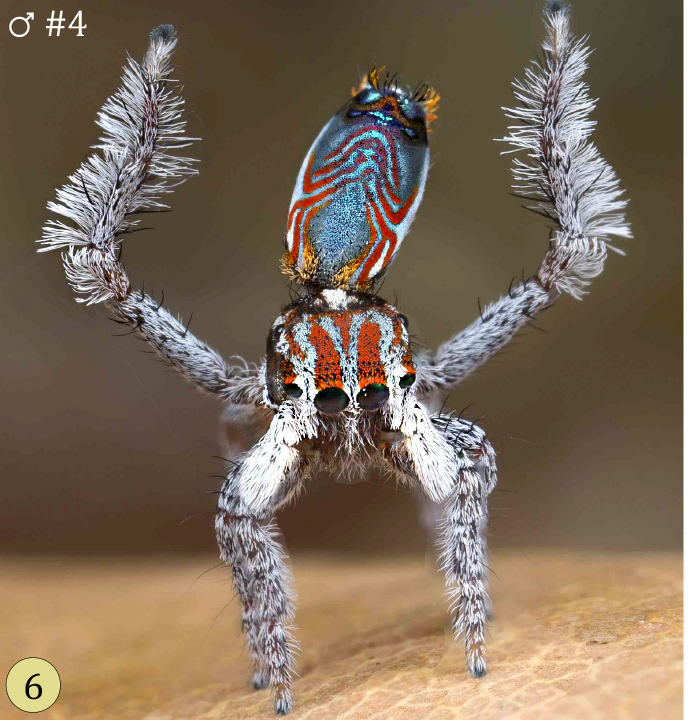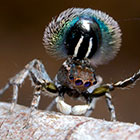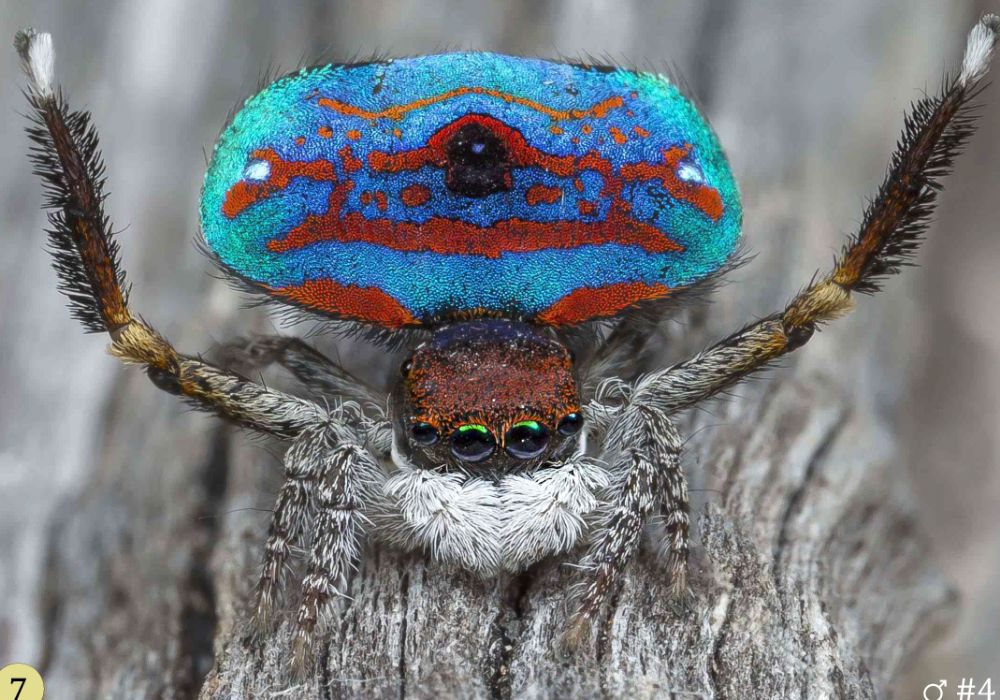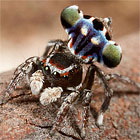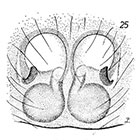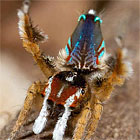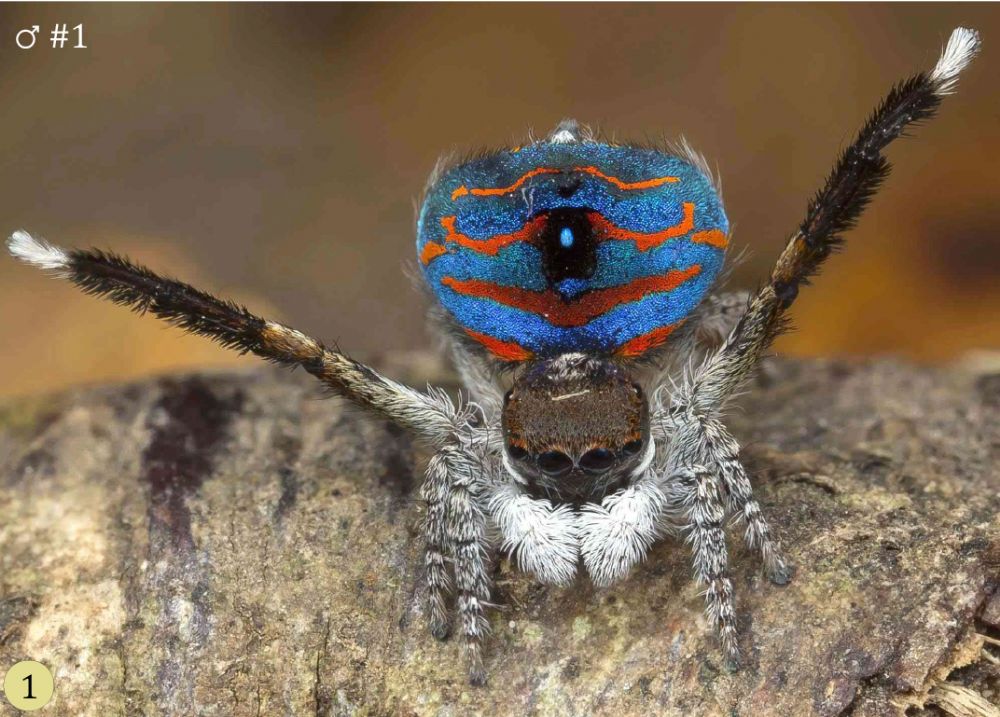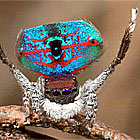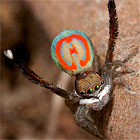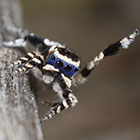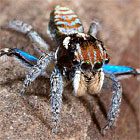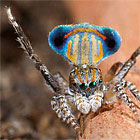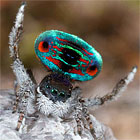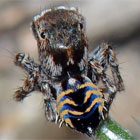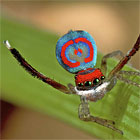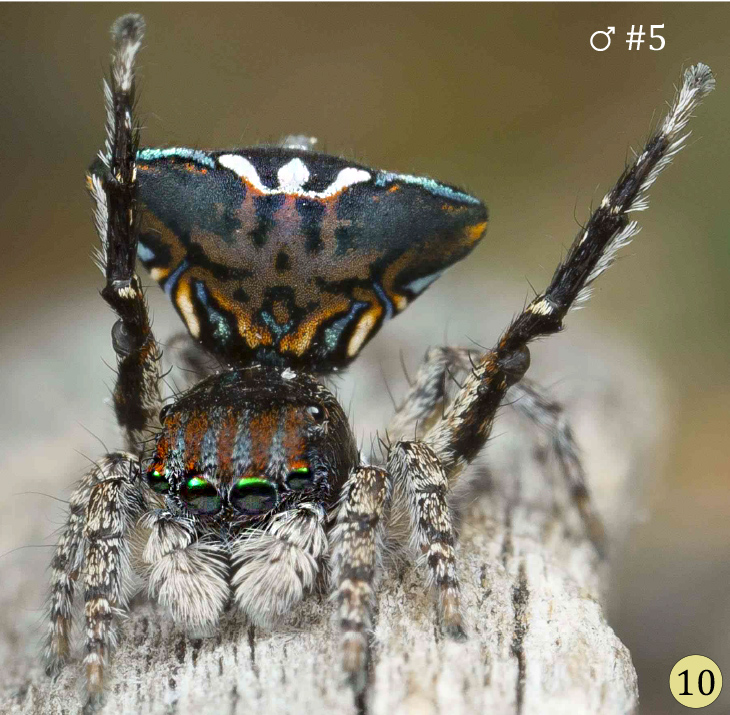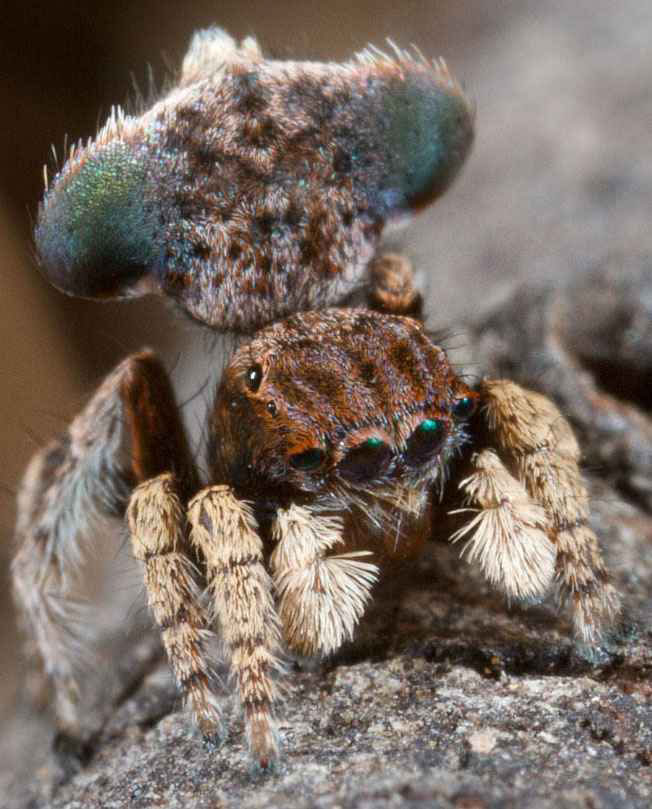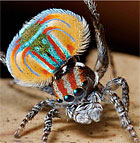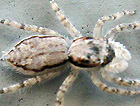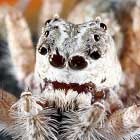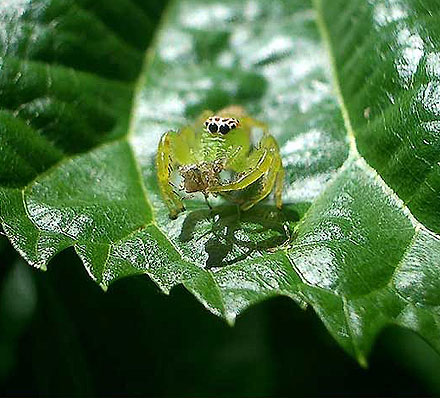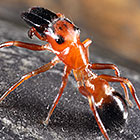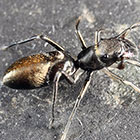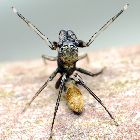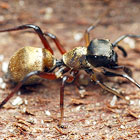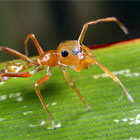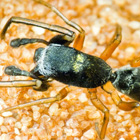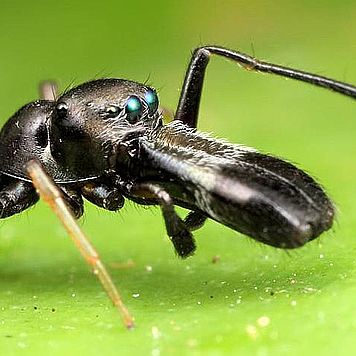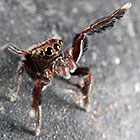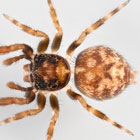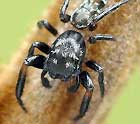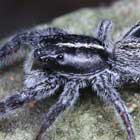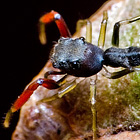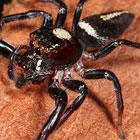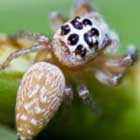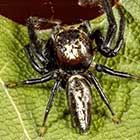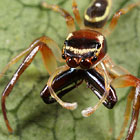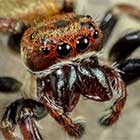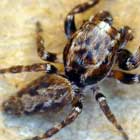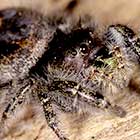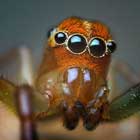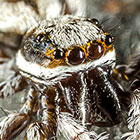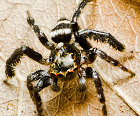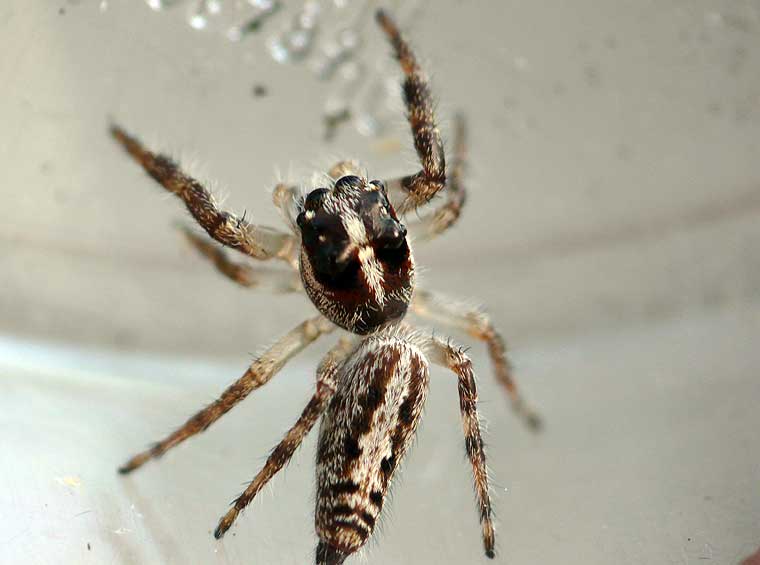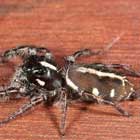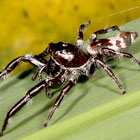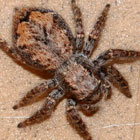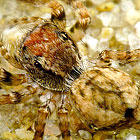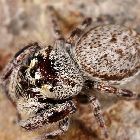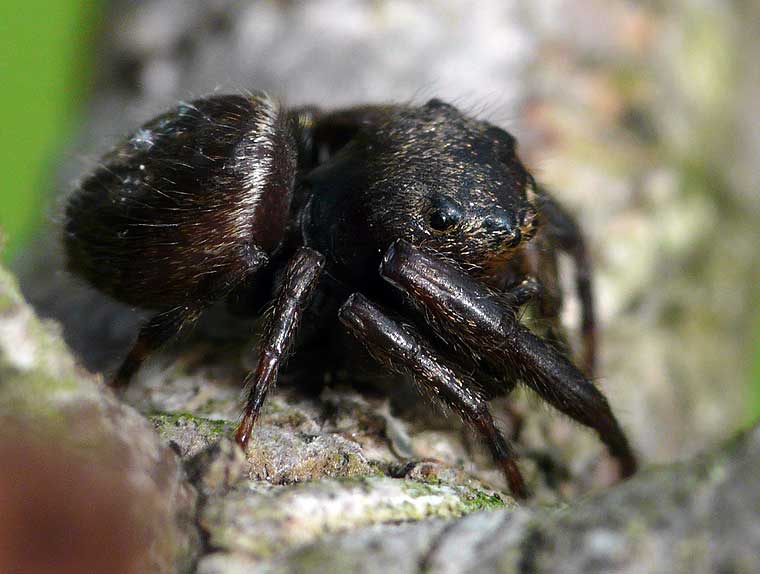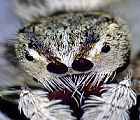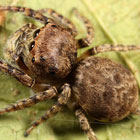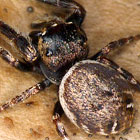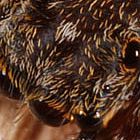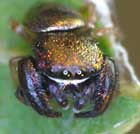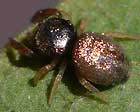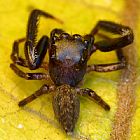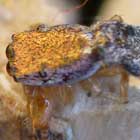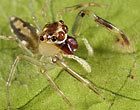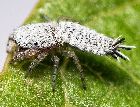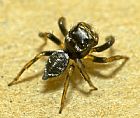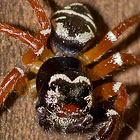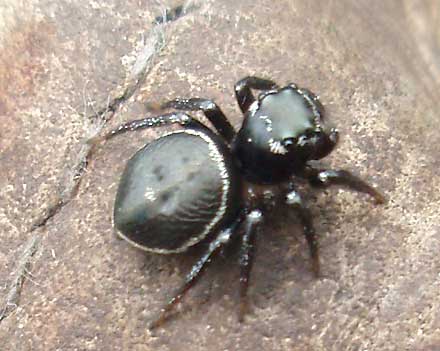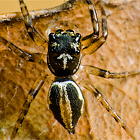Jumping spiders are the world's most diverse and abundant spider family, with over 500 genera and more than 5000 species, over 13 per cent of all spiders. They are easy to identify as no other spider family has two relatively enormous eyes in the middle of the front eye row They have become popular media stars with Youtube hits and thousands of macro photographs. The courtship of some genera including Maratus the Peacock Spiders feature a complicated ritual of leg waving, toe-tapping, abdomen twerking, and wing flapping. Australia. where they are they are particularly abundant and diverse, is a hot spot for jumping spiders.
Abracadabrella birdsvillei Zabka, 1991 Western Fly Mimic
An inland species with large, bulging, round, black-shiny 'eyes' on the rear of the abdomen, found mostly in south western Queensland, but also in... 
Abracadabrella elegans (L. Koch, 1879) Elegant Fly Mimic
A small to medium, flattish jumping spider with large, bulging, black-shiny 'eyes' on the rear of the abdomen, found mostly in Queensland, especially... 
Abracadabrella sp. nov. Could this be a new Abracadabrella sp.?
A small somewhat flattened rather hairy jumper from Darwin, with colours and patterning like an Abracadabrella sp. but without the two large... 
Adoxotoma nitida Gardzinska & Zabka, 2010 Sparkling Black Jumping Spider
The genus Adoxotoma is unified by characters which are variable enough to suggest it may contain more than one genus. This is supported by... 
Adoxotoma sp. Brown Mountain-rainforest Jumping Spider
Recognised informally from the photo by Wayne Maddison as an Astioid similar to specimens he found in Papua New Guinea. It is a unident, with a... 
Afraflacilla grayorum Żabka, 1993 Grays' Stridulating Jumping Spider
An impressive male with long hairs on a rather massive first leg, the embolus arising at about 6 o'clock on the face of the palp, circling 1.5 times,... 
Afraflacilla sp. Undescribed Afraflacilla 10 o'clock
Another Afraflacilla is not in the literature, having a palp (male genitalia) with an embolus arising at 10 o'clock. 
Afraflacilla sp. Undescribed Afraflacilla 3 o'clock
This Afraflacilla is not in the literature, having a palp (male genitalia) which is not depicted for described species. It is widespread from... 
Afraflacilla sp. Undescribed Afraflacilla Fatlegs
Like many species of Pseudicius, a sister genus to Afraflacilla this sp. has enlarged leg-one segments and large spurs on the tibia and... 
Afraflacilla stridulator Żabka, 1993 Western Stridulating Jumping Spider
The female of this species is rather flattened with an attractive pattern of black blobs around the upper surface of the abdomen at the rear. It was... 
Ananeon sp. aff. Ananeon howardensis (but probably not)
Despite this species having a near identical male palp to Ananeon howardensis and in one case pretty much the same location it appears to be... 
Arasia mollicoma (L. Koch, 1880) Flat-white Jumping Spider
A small to medium-sized bark dweller in dry eucalypt country. Females around 5-6mm. One of the many Astiae spiders in a group that live on and under... 
Astia hariola Koch 1879 Gypsy Jumper
A common, mostly black, slender jumper recognised by yellow bands across the rear of the abdomen, found in Queensland and NSW, often under loose bark, especially in eucalypt forests. Females build a flattish, shallow, oval silken retreat. Golden and yellow markings on the upper surface near the spinnerets are brighter on the male than on the female. The male palp has a distinctively curved... 
Astilodes mariae Zabka, 2009
A new genus from Queensland recently described by Dr Marek Zabka. This specimen about 10mm long with a very skinny abdomen and long front legs. This... 
Bavia aericeps Simon, 1877 Giant Tropical Bavia
Bavia aericeps is the type species for Bavia. In its distribution range, from Malaysia to Australia and on several Pacific Islands, it is the most... 
Canama Kochi (Thorell, 1881) White-striped Canama
Canama kochi (currently misplaced in Bathippus is medium-sized to large, very athletic, with very large forward-pointing jaws, found... 
Chalcolecta prensitans (Thorell, 1881) Slender Northern Jumping Spider
Thorell originally described this species as both Marptusa prensitans and Marptusa rapax. ♀ 3 mm ♂ 4 mm

Clynotis severus Stern Jumping Spider
Variable in pattern, colour and also size, the name (meaning severe) refers to the glowering appearance caused by the lines on the carapace, making... 
Coccorchestes ferreus Griswold, 1984 Beetle Mimicking Salticid
This jumping spider is one of the most unusual of the jumping spiders found in Australia, having over time successfully adapted by mimicking a... 
Copocrossa sp
Photographed by Brodie Foster on the Sunshine Coast hinterland this is possibly a new species of Copocrossa so far only recorded for NQ. 
Cosmophasis baehrae Zabka & Waldock, 2012 Baehr's Jumping Sppider
Found in medium to densely vegetated environments, possibly gardens. There is some iridescence, distinct white markings on the face and abdomen, and... 
Cosmophasis bitaeniata (Keyserling, 1882) Green Tree Ant Cosmophasis
A jumping spider found in New Guinea, Australia and Micronesia. Cosmophasis bitaeniata is a myrmecophilic associate of the green tree ant,... 
Cosmophasis lami Berry, Beatty & Prószyński, 1997 Lami Beach Cosmophasis
A small, golden, slender jumping spider found along waterways and in rainforest in Fiji, the Cocos Islands, and now Townsville. This is a unident... 
Cosmophasis micarioides (L. Koch, 1880) Grainy Cosmophasis
A common, abundant and extremely variable species across northern Australia in well-vegetated areas, whose range seems to be extending southward. 
Cosmophasis thalassina (L. Koch 1880) Sea-green Jumping Spider
Cosmophasis micans, the name often associated with this species, does not exist in Australia, it was a misidentification in Koch & Keyserling... 
Cytaea alburna White striped Cytaea
A small to medium-sized jumping spider, females to 7mm, males darker and smaller, to 6mm. Usually found wandering on foliage where they are well... 
Cytaea aspera Grey Striped Bark Jumper
A common, widespread medium-sized jumper, body length around 8mm, found on grey bark in coastal areas in Queensland and in many habitats elsewhere. 
Cytaea plumbeiventris (Keyserling, 1881) Slate-bellied Cytaea
A complex of Cytaea spp. used as a synonym of Cytaea expectans and Cytaea xanthopus but not convincingly. These two species... 
Damoetas nitidus (L. Koch, 1880) Shining Damoetas
Damoetas is one of the more obscure genera of spiders in the ant mimicking containing also Ligonipes, Rhombonotus, and Myrmarachne. Damoetas nitidus is a small spider, the body length of female about 3mm, rarely 4mm, the male 2.5-3mm. This spider has an abdomen... 
Damoetas sp. Ku-rin-gai Ant Mimic
Several apparently widespread Damoetas spp are rather hard to tell apart from other small ant mimics like Ligonipes and Rhombonotus, except for the lack of fringing on the front legs. Ligonipes and Rhombonotus have prominent thick black clumping fringes of hairs... 
Damoetas sp. Shaggy Damoetas
This jumper resembles Damoetas nitidus in many respects, having posterior median eyes closer to the anterior eyes than the posterior lateral... 
Euryattus bleekeri (Doleschall, 1859) Bleeker's Jumping Spider
A common jumping spider, variable in size, colour and pattern, with a range from Northern NSW to Sri Lanka, probably also elsewhere in eastern Australia. Females can be up to 10mm in body length, the males smaller, up to about 6mm. They are abdundant on shrubs in coastal areas, especially near the sea, in thick scrub behind dunes. They prefer relatively thick but dry foliage, such as dense shrubs... 
Euryattus sp. Northern Jumping Spider
A large, robust jumping spider common around Cairns, North Queensland. The spider is fissident meaning it has a large double pointed tooth on the... 
Evarcha infrastriata (Keyserling, 1881) Striped Evarcha
First described as Hasarius infrastriata in 1881, this small spider is widespread in coastal and hinterland eastern Australia, on grasses and... 
Evarcha longula (Thorell, 1881) Brothel Creeper
Barry Richardson was asked by the referees of his paper describing this species to include it in Evarcha rather than erecting a new genus... 
Hasarius adansoni (Audouin, 1826) Adanson's House Jumping Spider
A lively, inquisitive and audacious cosmopolitan species found in most of Australia except very cold places and deserts. It is mostly found in or around buildings. It is naturally distributed in... 
Helpis minitabunda (L. Koch 1880) Threatening Jumping Spider
Helpis minitabunda is found on foliage in most habitats in Eastern Australia, also in New Guinea and New Zealand, often abundant in gardens. Like most jumping spiders it is very agile and fast. It seems confident in its ability to jump to safety, allowing quite close approaches. When... 
Holoplatys lhotskyi Zabka, 1991 Queensland Ultraflat
A small, extremely flat spider usually on or under bark. Males and females both variable in size, to about 6mm body length. The holotype (described specimen) was collected by Val Davies at her home in Fig Tree Pocket on 29 January 1973. It has been found in other areas of Brisbane, Queensland,... 
Holoplatys planissima (L. Koch, 1879) Grooved Jumping Spider
A medium-sized jumping spider usually on or under eucalypt bark in most parts of continental Australia from Western Australia to Queensland. Often... 
Holoplatys sp Small Holopplatys
This small flat spider, a Holoplatys species, was collected at Freshwater National Park, the body length about 4mm. 
Hypoblemum griseum (Keyserling, 1882)
Common in Queensland, New South Wales and most of New Zealand south to Christchurch, often seen around built up areas on walls and fences during the warmer part of the day. Known as 'House Hopper' it is among the most obvious and encountered spiders on NZ's North Island. It is a very mobile spider... 
Hypoblemum scutulatum (Keyserling, 1882) White-banded House Jumper
This species has a small male, 3.5 - 4mm body length, the female being Lycidas scutuatus often seen around built-up areas on walls and fences during the warmer part of the day. Very mobile, quick to jump. It does not have a high white garland around the head but has fluffy white pedipalps,... 
Hypoblemum scutulatum (L. Koch, 1881) Cross-ruled Lycidas
A common jumping spider on the bark of trees, leaves and other surfaces, body length of females to 7mm, males to about 5mm, found in Queensland and NSW and likely elsewhere across Australia in suburban parks and gardens, dry eucalypt scrub to rainforest. Usually abundant when found, mostly on low... 
Hypoblemum scutulatum (was Lycidas karschi Zabka 1987 Karsch's Lycidas)
A medium sized jumping spider abundant on foliage and in leaf litter in dry rainforest, especially along creeks. Same as Hypoblemum (Lycidas)... 
Jotus sp. L. Koch, 1881 A Jotus sp.
An agile, small jumping spider found on the ground, on low foliage and in leaf litter in heavily to sparsely vegetated areas in coastal eastern... 
Jotus sp. South Australia. Undescribed "Tony".
A jumping spider with green anterior median eyes, whose male has large, prominently fringed legs 1 and 2 and banded hairy pedipalps, found on low... 
Judalana lutea Rix, 1999 Judy and Alan's Yellow Ant-mimicking Jumping Spider
This species, described by Michael Rix in 1999, is a small, slender ant-mimicking salticid in Southeast Queensland with a bright, yellow-orange abdomen, closely related to the other four genera of Australian plurident ant mimics: Ligonipes, Rhombonotus, Damoetas and Myrmarachne. It is found mainly on Acacia bushes and occasionally on eucalypts, where leaves have been... 
Ligonipes lacertosus (Thorell, 1881) or Ligonipes semitectus (Simon, 1900)
An ant mimic with a golden section of the abdomen, apparently mimicking ants. Common in the hills around Brisbane, also found on the coast, and out to Carnarvon. Prefers dry eucalypt forest. Characteristics of this slender ant mimic with long spines on the tarsus include tufts of thick hairs on the... 
Ligonipes sp. 'white-brows' White-browed Ligonipes
This small ant-eating ant-mimic is mostly found in or near a rolled leaf retreat in lush habitats in South East Queensland, including gardens. Its range probably extends further. The female can grow to 4mm, the male to around 3.5mm. The front legs seem to mimic an ant's antennae. The body is dark... 
Lycidas chrysomelas (Simon, 1909) Maratus-like Lycidas
A small Lycidas closely related to Maratus and sharing with Maratus the multicoloured iridescent upper surface of the abdomen... 
Maratus albus Otto & Hill 2016 White-haired Peacock Spider
Males of this coastal species extend their long legs III but do not elevate their fan during courtship display. They are found along Australia's... 
Maratus amabilis Karsch 1878 Amiable Peacock spider
Maratus amabilis is the earliest described and therefore the type species for Peacock Spiders. The large black spots on the flaps of this... 
Maratus anomaliformis (Keyserling, 1893) Pseudo-unusual Peacock Spider
This species was first named Habrocesum nigriceps, but when it was put into Maratus its species name was preoccupied and so a new... 
Maratus anomalus (Karsch 1878) Unusual Peacock Spider
This species is one of a few Maratus to lack an extendable flap. However it waves its shiny, colourful abdomen and legs like much like those... 
Maratus anomalus group "Bluey" Marlborough Queensland
A small spider even by Maratus standards, in sparse bush in the hinterland of the Central Queensland coast. The eyes reflect green while the silvery hairs on the head and abdomen reflect pale blue. ♀ ?mm ♂ 2.4mm 
Maratus aurantius Otto & Hill 2017
This is one of the grassland peacock spiders, known only from one locality near Orange, New South Wales. 
Maratus australis Otto and Hill, 2016 Southern Peacock Spider
This Peacock Spider from the south coast of WA is similar to and closely related to Maratus tasmanicus. It is found in leaf litter. Males... 
Maratus cristatus Otto and Hill 2017 Tufted Peacock spider
This species is close to Maratus vespa Otto & Hill 2016 (male and female genitalia, long bristle-like hairs on legs III, and general features... 
Maratus electricus Otto and Hill 2017 Circuit-board Peacock spider
Maratus electricus is similar to M. linnaei Waldock 2008 and both species are placed in a new clade, the linnaei group. Males of the... 
Maratus fimbriatus Otto & Hill 2016 Fringed Peacock Spider
Jurgen Otto found this species in 2014 while travelling in northern NSW. It is the only male peacock spider Jurgen has seen displaying to the female... 
Maratus gemmifer Otto and Hill 2017 Jewelled Peacock spider
A species in the mungaich group with a large central black patch on the male's fan. There are six other species In the mungaich group with a large... 
Maratus harrisi Otto and Hill, 2011 Harris's Peacock Spider
This spider is named after its discoverer, Stuart Harris, who found a single male at Boroomba Rocks (Namadgi National Park) south of Canberra,... 
Maratus kochi (Żabka 1987) Koch's Peacock Spider
The holotype female from Peak Downs (Capella QLD) described by Żabka resembles the female ofM. cinereus and M. lentus leading Otto... 
Maratus linnaei Waldock 2008
Julianne Waldock described the male and female of this species from specimens collected since 1995 at Two Peoples Bay Nature Reserve in Western... 
Maratus melindae corus Otto and Hill 2017 North-western subspecies of Melinda's Peacock spider
This is a subspecies of Maratus melindae Waldock 2013. Maratus melindae corus closely resembles the type of M. melindae... 
Maratus mungaich Waldock 1995
This colourful spider with very large flaps is restricted to the extreme southwestern corner of Western Australia. 
Maratus pavonis (Dunn 1947)
Dunn's Peacock Spider - pavo means peacock - is widely distributed across the southernmost parts of Australia, from Tasmania and Victoria in... 
Maratus personatus Otto & Hill, 2015 World's Cutest Spider
This is the world's cutest spider, according to popular internet magazine Verge (and who could disagree?) It is Maratus personatus, a... 
Maratus sp. Blue-thighed Peacock Spider
In some respects this spider, known informally as the Blue-thighed Peacock Spider resembles M. linnae, but is clearly another species. Its... 
Maratus sp. Stanley, north west Tasmania
This species from Stanley, north west Tasmania has dark lateral spots, a feature also seen in several other Maratus species and small dark... 
Maratus sp. Stirling Ranges Darlington's Peacock Spider
This Martus sp. known informally by this temporary common name in honor of its discovery by the naturalist-explorer Dr. Philip Jackson Darlington Jr,... 
Maratus spicatus Otto & Hill 2012 Striped-blue-and-gold Western Peacock Spider
A small species, distinct and recognizable, found in Western Australia on the Canning River East Branch, 30 km south of Armadale, in bushland... 
Maratus splendens (Rainbow 1896)
This close relative of the widely-distributed M. pavonis has been found around Sydney, the NSW central Coast, Hunter Vaslley and Coffs Habour. 
Maratus trigonus Otto and Hill 2017 Triangular-crowned Peacock spider
The pattern of scales on the fan of Maratus trigonus includes a threepointed "crown" of bright white scales at the rear margin. The sharp... 
Maratus vespertilio (Simon 1901) Bat-like Maratus
This cryptic, little-known species has a wide distribution across southern Australia. It has a much less flamboyant colouration than its close... 
Maratus volans (O. Pickard-Cambridge 1874) Flying Peacock Spider
The 'Flying Peacock Spider', like all other Maratus spp., does not fly. The 'wings' are for courtship display. This Maratus is... 
Menemerus bivittatus (Dufour, 1831) Cosmopolitan Jumping Spider
Note: some Menemerus bracteatus also on this page.
This is a cosmopolitan jumping spider associated with humans in the warmer parts of the world, found in houses and on walls in cities. In Australia it has been reported in coastal Queensland. Both the female and the male have white fringing... 
Mintonia sp. QLD (Davies & Zabka, 1989) Queensland Mintonia
This medium-sized jumper from north Queensland rainforest and rainforest edges resembles the more famous Portia fimbriata , with strange,... 
Mopsus mormon Karsch, 1878 Northern Green Jumping Spider
The genus Mopsus has only one spider - Mopsus mormon, previously Mopsus penicillatus. It is the largest Australian jumping spider, found throughout the warmer regions in the northern part of Australia down as far as Coffs Harbour. Green Jumping spiders are large, beautiful,... 
Myrmarachne bicolor (L. Koch, 1879) Two-coloured Ant Mimic
A small, slender ant mimic, sometimes entirely dark brown to black, but mostly with a red or orange mid-section, imitating Opisthopsis... 
Myrmarachne luctuosa (L. Koch, 1879) Mournful Ant Mimic
Widespread and common ant mimic in coastal and inland eastern Australia, including Tasmania, in several distinct forms. Most specimens have a gold... 
Myrmarachne luctuosa Polyrachis Ant Mimic
The golden-tailed ant mimics in Myrmarachne mimic various species of Polyrhachis ants, of which there are many in South East Queensland, including some not yet described (Burwell, pers. comm). These spiders are good specific mimics, usually associating with just one species of ant. They do not prey on the ants. The mimicry is used for protection, ants being not as much sought after... 
Myrmarachne macleyana Ant Mimic
This golden-tailed ant mimic appears to be mimicking Polyrhachis rufifemur, the Red-thighed Polyrhachis, common in South East Queensland. The mimicry is shown in the photo by Brodie Foster of a specimen from near Mooloolah of the spider (top) and the ant (below). This spider is widespread in Queensland. In Cairns it is associated with Polyrhachis foreli and P. cupreata. 
Myrmarachne smaragdina Ceccarelli, 2010
A small to medium-sized, slender spider in rainforest and open woodland in northern Australia. The female nearly perfectly mimics the green ant,... 
Myrmarachne sp. Ant Mimic
This common Myrmarachne found in late October in many locations west of Brisbane does not have the greatly extended male chelicerae of many others in this genus. Its name will be revealed in a revision due to appear in 2015♀ 4mm ♂ 4mm 
Myrmarachne sp. Gladstone
A rattle ant mimic observed in a Gladstone garden, possibly a widespread species, living near rattle ants, Polyrachis spp. Brian Seccombe... 
Neon australis Richardson, 2013 Australian Neon
A tiny spider, the male only 2.5mm total body length, common in leaf-litter from South Australia to South East Queensland, cryptically coloured... 
Neon sp. A Jumping Spider
Spiders in the genus Neon have not, as of this writing, been recorded for Australia, with the possible exception of Barrow Island in Western... 
Ocrisiona jovialis (Koch L., 1879) Jovial Jumping Spider
A common and widespread jumping spider in most habitats along coastal eastern Australia including Tasmania. It is a flattish jumper with rather chubby front legs. The female has obvious white hairs on the pedipalps and a strong, yellow-banded pattern at the rear of the upper surface of the... 
Ocrisiona leucocomis (L. Koch, 1879) White-striped Ocrisiona
This widespread Salticid is a bark-dweller with a flat body, mostly black with a thin longitudinal line on the carapace and diffuse white markings in... 
Ohilimia scutellata (Kritscher, 1959) North Queensland Ohilimia
The North Queensland Ohilimia is a mostly black, attentuated ant-like spider with brilliant red front legs. The genus can be recognised by... 
Opisthoncus grassator Keyserling, 1883 Wandering Vagabond
Attractive, large, and with an outgoing personality, the male is usually found hunting on shrubs in daylight. It has a white to cream patch on rear of the head and a white to cream stripe running lengthways along the abdomen. Very common. Perhaps the most commonly seen and photographed garden jumping spider. The name means highwayman or footpad, a type of brigand operating on foot, robbing... 
Opisthoncus polyphemus (L. Koch, 1867) Cyclops Jumping Spider
A widespread and common medium-sized jumping spider, possible several species. female body length 8-9 mm, the male 6-7 mm, in eucyalypt forest, heathland and woodland to dry rainforest in New Guinea, Queensland, New South Wales and Western Australia. The body is pale yellow-orange with white... 
Opisthoncus quadratarius (L. Koch, 1867)?
A large, robust and powerful jumping spider found in gardens, houses, along waterways and in woodland in South East Queensland. Its teeth and palp... 
Opisthoncus sp. Two spot big jaw northern
A distinctive, medium-sized, Opisthoncus in Far North Queensland The male has very large jaws with large curved teeth and long fangs. 
Opisthoncus squint (New species)
Salticidae Opisthoncus 'squint' because of very small posterior lateral eyes, apparently covered with short cream and ginger hairs, smalll body... 
Paraphilaeus daemeli (Keyserling, 1883) Daemel's Trite
This widespread and common, well camouflaged Salticid is usually found wandering on foliage in dry eucalypt scrub to rainforest margins, even grasslands, throughout coastal Queensland and NSW, possibly elsewhere. Well camouflaged. The body is a cryptic pattern of buff-cream to brown with patches... 
Phidippus audax (Hentz, 1845) Audacious Jumper
Finding this species in Norman Park, a suburb of Brisbane, Queensland, is unusual because it is a North American spider. On the other hand it is a... 
Prostheclina bulburin or amplior Richardson & Zabka, 2007 South East Queensland Prostheclina
A delicate and attractively coloured jumping spider found in coastal Queensland on foliage in tropical and temperate rainforests or wet eucalypt forest, frequently on ferns. As of 2007 there are seven species, the one in South East Queensland generally being P. bulburin recognizable for the tufts of black hairs on the front legs, though ranges most likely overlap. P. pallida is found all up the south eastern Australian coast,... 
Psenuc courti (Zabka, 2002) Court's Stridulating Jumping Spider
Psenuc is a new genus for some of the jumping spiders previously in Afraflacilla and Pseudicius, created by Jerzy Prószyński in 2016. 
Saitis virgatus Otto & Hill, 2012 Striped Saitis
A small jumper common in Sydney's north on the Hawkesbury inlet at Cowan Creek, also north to at least Brisbane and south to Eden. Males have long,... 
Sandalodes bipenicillatus (Keyserling, 1882) Two-tufted Sandalodes
This attractive jumping spider is of medium size, female: 10 mm, male: 9 mm. Found on bark and green leaves. The male has two brushes of dark hairs that form forward-pointing horns on the sides of the spider's head, thus the species name. It was named in 1882 by Keyserling as Mopsus which it... 
Sandalodes scopifer (Karsch, 1878) White-spotted Sandalodes
A rather large jumping spider, dark brown to black, throughout Australia and also known from New Guinea, often found on wattles and gums. Body... 
Sandalodes superbus (Karsch)
The largest and most robust species of Sandalodes. The male has cheliceral spurs (on the jaws) with distinctive protrusions and a fringe of... 
Servaea incana (L. Keyserling, 1878) Hoary Servaea
A medium-sized jumping spider in the eastern states of NSW, Victoria and Tasmania, in most habitats. A photogenic species, quite content to sit in... 
Servaea villosa (Keyserling, 1881) Shaggy-velvet Servaea
A medium-sized jumping spider in coastal Queensland, probably elsewhere. Common in winter and spring in South East Queensland as mature breeding males and females. Very similar to Servaea incana except smaller, as much as half the size, with a great variety of patterns and colours, including... 
Simaetha sp NQ Simaetha
A blocky looking jumping spider with relatively small posterior lateral eyes and tiny posterior median eyes. 
Simaetha species S. thoracica and S. tenuidens (Brown Jumpers)
These two species are common jumping spiders in suburban gardens and parks. S. thoracica probably the more common of the two, female body length about 6 mm, male about 5 mm. S. tenuidens may be a little larger and longer (about 7-8mm both males and females according to Hawkeswood) and have less... 
Simaetha tenuidens (Keyserling, 1882) Brown Jumper
A species known in all coastal parts of eastern Queensland and likely to be recorded elsewhere in eastern Australia. This species is large and... 
Simaetha tenuior (Keyserling, 1882) or a related species
A brown Simaetha with an attractive pattern on the abdomen. 
Simaetha thoracica Thorell 1881
A blocky, robust jumper of medium size, female body length about 6 mm, male about 5 mm. They have golden scales, often rubbed off in larger... 
Simaethula sp
A Simaethine probably Simaethula because of its small size the eye region apparently covering more than half the carapace. 
Simaethula sp Elegant White-moustached Simaethula
Simaethula is a genus of small jumping spiders very closely related to Simaetha. They are smaller than Simaetha and do not have the banded rear of the abdomen. Females are generally 2-4mm and males 1-3mm. The upper surfaces of the cephalothorax and abdomen are covered with scales, usually golden, though they can appear differently coloured in differently coloured lights. The... 
Simaethula sp. Small Golden Simaethula
Simaethula is a genus closely related to Simaetha and endemic (only found in) Australia. It is smaller than Simaetha. These juveniles (about 1.5mm body length) were shaken out of a Lilly Pilly. There were several. They could be S. aurata (gilded golden) or S. auronitens (golen and polished,... 
Sondra aurea (L. Koch, 1880) Golden Sondra
A male Sondra aurea identified by Marek Zabka while in Australia in August 2010. Cephalothorax generally brown, fovea area and median part of... 
Tara? cf anomala (Keyserling, 1882) Ergane? cf cognata L Koch, 1881 Scorpion Mimic
Body length males 3.2mm interesting for a number of features: small size, habitus and behaviour very scorpion like, extreme flatness, bulging femurs leg I, extremely strong-looking "crone-finger" fangs, with bumps and scoops, rather like Ergane cognata, or Tara anomala two slender... 
Tauala sp cf alveolatus Wanless, 1988
A beautiful North Queensland spider with a highly arched cephalothorax and huge eyes. The abdomen is slender and the legs partly transparent. Thanks... 
Urogelides daviesae Zabka 2009 Long-tailed Jumping Spider
An unusual spider in open sclerophyll forests dwelling in leaf litter, on vegetation and on Allocasuarina trees. The anal tubercle and posterior spinnerets are exceptionally long and make a kind of movable "tail" as in Uroballus. Unlike Uroballus this spider is unidentate and does not... 
Zenodorus durvillei (Walckenaer, 1837) d'Urville's Jumping Spider
A medium-sized ant-eating jumping spider known from New Guinea, its adjacent islands, and northern Australia, in rainforest and fringes. Both males... 
Zenodorus metallescens (Koch L., 1879) Cast-iron Zenodorus
A medium to large, powerful, robust, dark brown to black jumping spider with prominent white markings, found in north Queensland. The species name... 
Zenodorus orbiculatus (Keyserling, 1881) Round Ant Eater
A medium-sized jumping spider in coastal areas from southern NSW to Exmouth WA, probably in all Australian coastal areas including Tasmania. The body is brown to black, the female having a circular abdomen fringed with white, a white dot in the centre. Legs brownish to nearly black. Cephalothorax... 
Zenodorus swiftorum Zhang and Maddison, 2012 Swift's Omoedus
A medium-sized jumper named from specimens found in Papua New Guinea, where they were found on low bushes in an open disturbed area, also present in... 

